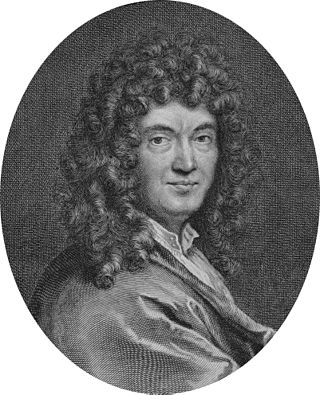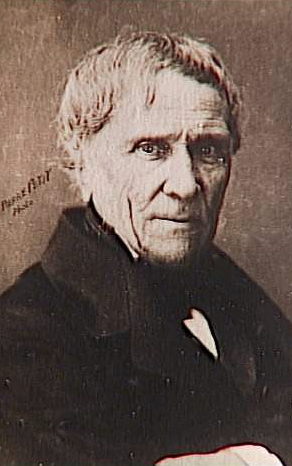Related Research Articles

Charles Émile Picard was a French mathematician. He was elected the fifteenth member to occupy seat 1 of the Académie française in 1924.

Adrien-Marie Legendre was a French mathematician who made numerous contributions to mathematics. Well-known and important concepts such as the Legendre polynomials and Legendre transformation are named after him. He is also known for his contributions to the method of least squares, and was the first to officially publish on it, though Carl Friedrich Gauss had discovered it before him.

Jean-Baptiste Biot was a French physicist, astronomer, and mathematician who co-discovered the Biot–Savart law of magnetostatics with Félix Savart, established the reality of meteorites, made an early balloon flight, and studied the polarization of light.

Jean-Henri Casimir Fabre was a French naturalist, entomologist, and author known for the lively style of his popular books on the lives of insects.

Claude Servais Mathias Pouillet was a French physicist and a professor of physics at the Sorbonne and member of the French Academy of Sciences.

Lambert Adolphe Jacques Quetelet FRSF or FRSE was a Belgian astronomer, mathematician, statistician and sociologist who founded and directed the Brussels Observatory and was influential in introducing statistical methods to the social sciences. His name is sometimes spelled with an accent as Quételet.

Pierre Maurice Marie Duhem was a French theoretical physicist who worked on thermodynamics, hydrodynamics, and the theory of elasticity. Duhem was also a historian of science, noted for his work on the European Middle Ages, which is regarded as having created the field of the history of medieval science. As a philosopher of science, he is remembered principally for his views on the indeterminacy of experimental criteria.

The year 1801 in science and technology involved some significant events, listed below.

Claude Perrault was a French physician and amateur architect, best known for his participation in the design of the east façade of the Louvre in Paris. He also designed the Paris Observatory and was an anatomist and author who wrote treatises on architecture, physics, and natural history.

Edme Mariotte was a French physicist and priest (abbé). He is particularly well known for formulating Boyle's law independently of Robert Boyle. Mariotte is also credited with designing the first Newton's cradle.

Jean Baptiste Perrin was a French physicist who, in his studies of the Brownian motion of minute particles suspended in liquids, verified Albert Einstein's explanation of this phenomenon and thereby confirmed the atomic nature of matter. For this achievement he was honoured with the Nobel Prize in Physics in 1926.

Antoine César Becquerel was a French scientist and a pioneer in the study of electric and luminescent phenomena.

François Sulpice Beudant was a French mineralogist and geologist. The mineral beudantite was named after him.

Sylvestre François Lacroix was a French mathematician.

Bernard d'Espagnat was a French theoretical physicist, philosopher of science, and author, best known for his work on the nature of reality. Wigner-d'Espagnat inequality is partially named after him.

Henri de Boulainvilliers was a French nobleman, writer and historian. He was educated at the College of Juilly; he served in the army until 1697.
Charles-Paul Diday was a French physician born in Bourg-en-Bresse.

Jacques Rohault was a French philosopher, physicist and mathematician, and a follower of Cartesianism.

Éleuthère Élie Nicolas Mascart was a French physicist, a researcher in optics, electricity, magnetism, and meteorology.

Traité de mécanique céleste is a five-volume treatise on celestial mechanics written by Pierre-Simon Laplace and published from 1798 to 1825 with a second edition in 1829. In 1842, the government of Louis Philippe gave a grant of 40,000 francs for a 7-volume national edition of the Oeuvres de Laplace (1843–1847); the Traité de mécanique céleste with its four supplements occupies the first 5 volumes.
Newton laid the foundations of Celestial Mechanics, at the close of the seventeenth century, by the discovery of the principle of universal gravitation. Even in his own hands, this discovery led to important consequences, but it has required a century and a half, and a regular succession of intellects the most powerful, to fill up the outline sketched by him. Of these, Laplace himself was the last, and, perhaps after Newton, the greatest; and the task commenced in the Principia of the former, is completed in the Mécanique Céleste of the latter. In this last named work, the illustrious author has proposed to himself his object, to unite all the theories scattered throughout the various channels of publication, employed by his predecessors, to reduce them to one common method, and present them all in the same point of view.
If one were asked to name the two most important works in the progress of mathematics and physics, the answer would undoubtedly be, the Principia of Newton and the Mécanique Céleste of Laplace. In their historical and philosophical aspects these works easily outrank all others, and furnish thus the standard by which all others must be measured. The distinguishing feature of the Principia is its clear and exhaustive enunciation of fundamental principles. The Mécanique Céleste, on the other hand, is conspicuous for the development of principles and for the profound generality of its methods. The Principia gives the plans and specifications of the foundations; the Mécanique Céleste affords the key to the vast and complex superstructure.
References
- 1 2 (in French) Françoise Khantine-Langlois (2006?), Un siècle de physique à travers un manuel à succès: le traité de physique de Ganot [A century of physics through a successful textbook: Ganot's treatise on physics] (English translation Archived 2 November 2014 at the Wayback Machine )
- ↑ Papanelopoulou, F.; Nieto-Galan, A.; Perdiguero, E. (2009). "Circumventing the "Elusive Quarries" of Popular Science: The Communication and Appropriation of Ganot's Physics in Nineteenth-Century Britain by Josep Simon". Popularising Science and Technology in the European Periphery (PDF). Ashgate: Aldershot. pp. 89–114. Archived from the original (PDF) on 29 June 2013.
- ↑ Simon, Josep; Herran, Nestor (2008). "The Franco-British communication and appropriation of Ganot's Physique (1851–1881)". Beyond Borders : Fresh Perspectives in History of Science (PDF). Newcastle upon Tyne: Cambridge Scholars Pub. p. 141ff. ISBN 9781847184832.